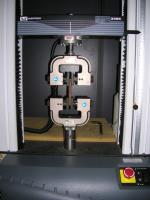 Add My Company
Add My Company
Sign In

We make no secret that we love steel and are extremely proud of the role that it plays underpinning the modern world. There are numerous favourable properties that various grades of steel have that make them not only ideal for the purpose but they perform functions that no other material could. Several things that we rely on, such as oil from deep sea drilling and the communication towers for mobile phones and 4G networks rely on quality steel, but how do we ensure that we use the right material for the job and that the product we have is up to code?
There are a number of tests for metals that give objective, lab-condition results to reliably show the mechanical properties and the various strengths in response to various forces and stresses that the material may be subjected to during normal and extraordinary usage.
One test measures tensile strength. Tension is a pulling force that acts at exact poles apart, 180 degrees away from each other. The example of tension known to every child involves the toy Stretch Armstrong; when you take hold of Stretch’s arms and pull in two exactly opposite directions, that is a tensile force. When testing metals, the forces must be much greater and more exact. A steel being tested for tensile strength is placed under ever increasing load until it can’t take any more and fractures. Usually there’s a degree of stretching – more accurately called elongation – until it reaches what’s known as the elastic limit and the steel is literally pulled in half. Tensile strength is very important in alloy steels, which need to resist forces applied gradually over time without deformation, fracture or buckling.
Impact testing is also very important for certain types of steel, which, in essence, is the ability of a material to accept a sharply delivered force, withstand the initial impact and then absorb or dissipate the energy without affecting the steel’s form. This is a very simple test, based on a pendulum action; a weight is swung on a solid bar from a fixed height and hits the test metal at the lowest point of the swing. The amount of energy taken to break the steel is calculated by the angle the pendulum takes after the impact. Interestingly, whereas other tests of properties required a new measurement factor to be invented, because impact is simply subjecting a metal to a force, it measures and states the amount of energy taken at impact, reporting in Joules. Alternatively, it’s sometimes applied as Joules per square centimetre or even kilograms per square centimetre.
As structures and engineering projects become ever greater, more expansive and more ambitious, the need to ensure that the characteristics of many special steels are capable of standing up to the stresses of their purpose. The strain on a three-storey building is very different compared to a skyscraper that’s several hundred feet tall. Not only must it be able to support the weight of the whole building, but do so for an extremely long time, which is why testing the mechanical properties of steel is such a crucially important role.
For more information on When the Time Comes to Test Your Mettle… or Metal talk to West Yorkshire Steel Co Ltd
Enquire Now
List your company on FindTheNeedle.

